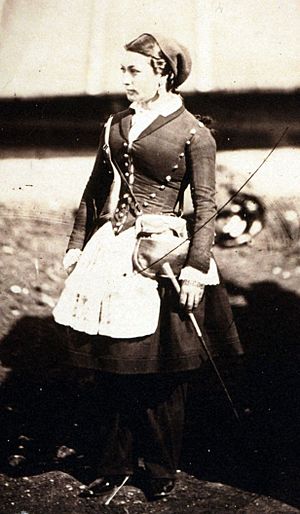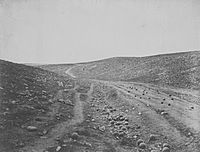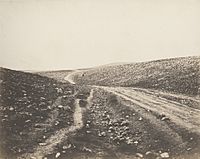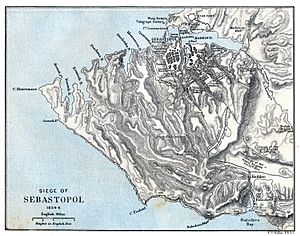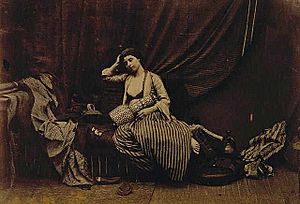Roger Fenton facts for kids
Quick facts for kids
Roger Fenton
|
|
|---|---|

Fenton, Self-portrait
|
|
| Born | 28 March 1819 Heywood, Lancashire, England
|
| Died | 8 August 1869 (aged 50) Potters Bar, Hertfordshire, England
|
| Education | University of London; Charles Lucy, Paris |
| Known for | Photographer and painter |
| Spouse(s) | Grace Elizabeth Maynard |
Roger Fenton (born March 28, 1819 – died August 8, 1869) was a British photographer. He is known as one of the very first war photographers in history.
Fenton grew up in a wealthy family in Lancashire, England. After studying arts at the University of London, he became interested in painting. His interest then shifted to the exciting new technology of photography. He saw early photos at the Great Exhibition in 1851 and was very impressed.
Within a year, Fenton started showing his own photographs. He quickly became a leading photographer in Britain. He also helped create the Photographic Society, which later became the Royal Photographic Society. In 1854, he was asked to go to Crimea. There, he took pictures of the final parts of the Crimean War.
Contents
Early Life and Photography Beginnings
Roger Fenton was born on March 28, 1819, in Heywood, Lancashire. His family was well-off. His grandfather was a rich cotton maker and banker. His father, John, was also a banker and a member of parliament. Roger was one of many children in his large family.
In 1840, Fenton earned a top degree from the University of London. He studied subjects like English, math, Greek, and Latin. He then started studying law in 1841. However, he became more interested in learning to paint.
Becoming a Painter
Fenton married Grace Elizabeth Maynard in 1843. He had likely visited Paris before this, where he might have briefly studied painting. In 1844, he registered as a copyist at the Louvre museum. He named Michel Martin Drolling as his teacher.
By 1847, Fenton was back in London. He continued to study painting with Charles Lucy, who became his friend. Fenton even showed his paintings at the Royal Academy in 1849, 1850, and 1851.
Discovering Photography
In 1851, Fenton visited the Great Exhibition in London. He was amazed by the photographs on display. This sparked his interest in photography. He then traveled to Paris to learn a photography method called the waxed paper calotype process.
By 1852, Fenton's photographs were being shown in Britain. He also traveled to places like Kiev, Moscow, and St. Petersburg to take pictures. He photographed landscapes and buildings around Britain too. In 1853, he helped create the Photographic Society. He became its first Secretary. This society later became the Royal Photographic Society.
Documenting the Crimean War
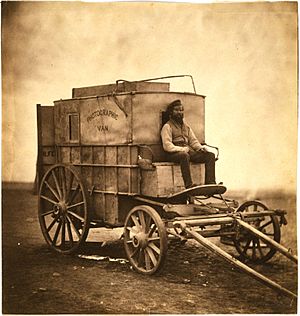
In late 1854, the Crimean War was a big topic in Britain. Powerful friends and supporters, including Prince Albert, asked Fenton to go to Crimea. They wanted him to photograph what was happening there. A London publisher, Thomas Agnew & Sons, supported his trip.
The photographs were meant to make the war seem less unpopular in Britain. They also aimed to balance out critical reports from newspapers like The Times. Fenton left on a ship in February 1855. He arrived in Balaklava on March 8 and stayed until June 22.
Challenges of War Photography
Fenton brought a helper, Marcus Sparling, a servant, and a large horse-drawn van. This van carried all his heavy camera equipment. Because his gear was so big, Fenton could only take pictures of things that stayed still. The photographic materials of that time needed long exposure times. This meant he mostly took posed pictures.
He photographed the landscape, including an area near where the famous Charge of the Light Brigade happened. This event was made famous by Tennyson's poem. The photograph does not show the exact spot of the charge. That place was a long valley several miles away.
Soldiers called the original valley "The Valley of Death." Tennyson's poem used this phrase too. So, when Thomas Agnew showed Fenton's picture in September 1855, he called it The Valley of the Shadow of Death. This name reminded people of Psalm 23 from the Bible.
In 2007, filmmaker Errol Morris visited Sevastopol to find the exact spot of this famous war photograph. He found a small valley, marked on a map as "The Valley of the Shadow of Death." This was where Fenton took his picture.
Fenton took two pictures of this area. One showed cannonballs on the road, and the other had an empty road. Morris found clues that the photo without cannonballs was taken first. He wondered if Fenton moved the cannonballs onto the road for the second picture to make it more dramatic. Another idea is that soldiers were collecting cannonballs and threw them onto the road for later pickup.
Other art experts, like Nigel Spivey, think the pictures are from the nearby Woronzoff Road. In June 1855, artist William Simpson drew the Woronzoff Road. His drawing also showed cannonballs placed like Fenton's. Simpson's publisher also used the title "The Valley of the Shadow of Death." Local tour guides agree this is the correct spot.
Despite hot summer weather and getting sick, Fenton took over 350 large photographs. An exhibition of 312 of his prints soon opened in London. It then traveled to other places in Britain. Fenton also showed his work to Queen Victoria and Prince Albert. He even showed them to Emperor Napoleon III in Paris. However, the photographs did not sell as well as hoped.
Life After Crimea
Even though his Crimean photos didn't sell much, Fenton kept traveling around Britain. He took pictures of landscapes and still life. But as time went on, photography became easier for everyone to do. Many people started taking quick portraits to earn money.
Fenton came from a rich family and probably didn't like this "trade" photography. He still wanted to make money from his art by taking special pictures and selling them for good prices. This caused disagreements with other photographers. Many of them needed to earn money and were willing to make their art "cheaper," as Fenton saw it. He also disagreed with the Photographic Society, which thought photographers shouldn't make money from their talent.
During this time, Fenton photographed places like the City of Westminster. He took pictures of The Palace of Westminster in 1857, while it was still being built. These are likely the earliest photos of the building. They are also the only ones showing the Clock Tower before it was finished.
Later Work and Legacy
In 1858, Fenton created studio pictures based on romantic ideas of Muslim life. An example is Seated Odalisque. He used friends and models, who sometimes didn't look very convincing in their roles.
Fenton's photography career lasted only a bit more than ten years. In 1862, he sold all his equipment and stopped being a photographer. He went back to studying law and became a lawyer. He was almost forgotten when he died seven years later. However, art historians later recognized him for his important and artistic work.
In 1862, a big exhibition in London decided to put photography with machinery and tools. They didn't put it with other fine arts, as had been done before. For Fenton and many others, this showed that photography was seen as less important. Many early photographers then moved on to other things.
Roger Fenton died on August 8, 1869, at age 50, after a week-long illness. His wife died in 1886.
In 2005, 90 of Fenton's pictures were shown in a special exhibition. This show at the Tate Britain gallery in London honored him as a "most important nineteenth-century photographer." In 2007, Fenton was added to the International Photography Hall of Fame and Museum.
Images for kids
See also
 In Spanish: Roger Fenton para niños
In Spanish: Roger Fenton para niños
- History of photography
- Felice Beato
- John McCosh
- L'Entente Cordiale
- The Queen's Target


